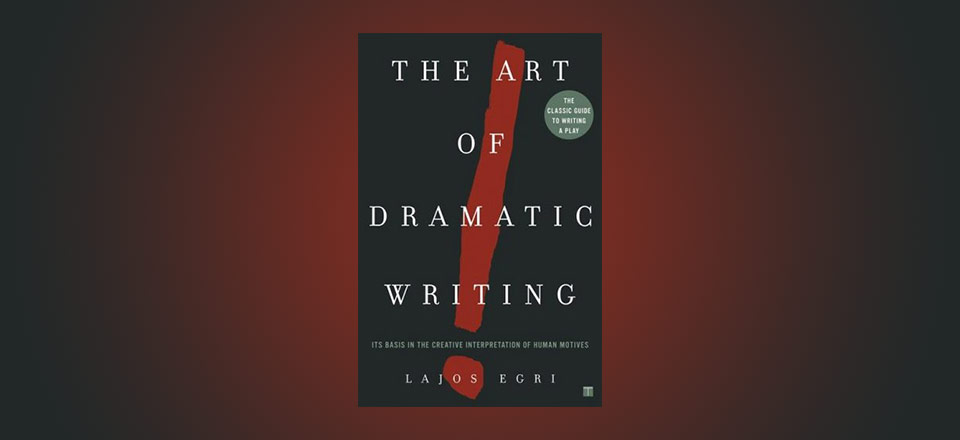The Art of Dramatic Writing by Lejos Egri has been a favorite resource of mine for several years. While it is specifically written for playwrights, it’s easy to take the principles taught and apply them to any type of dramatic writing.
Egri’s approach to writing is strict and scientific. He believes that a good story should begin with a clear premise; a single sentence forming a thumbnail synopsis of the entire piece.
This super specific “story goal” is then achieved by carefully crafting characters that when brought together under the right circumstances, will naturally drive the story forward from beginning to inevitable end.
It’s a beautiful theory and one of the most rigorous approaches to character development I know of. This excellent and relatively quick exercise consists of answering fewer than 30 questions about your character.
Creating Characters That Drive Plot
Every object has three dimensions: depth, height, width. Human beings have an additional three dimensions: physiology, sociology, psychology. Without a knowledge of these three dimensions we cannot appraise a human being.
–Lajos Egri
As stated in the quote above, Egri’s method involves coming to an intimate knowledge of your fictional character’s physiology, sociology, and psychology in order to understand how they might behave in any given situation. Below are the questions he proposes you answer in order to do so.
Physiology
- Sex
- Age
- Height and weight
- Color of hair, eyes, skin
- Posture
- Appearance: good-looking, over-or-underweight, clean, neat, pleasant, untidy. Shape of head, face, limbs.
- Defects: deformities, abnormalities, birthmarks. Diseases.
- Heredity
Sociology
- Class: lower, middle, upper.
- Occupation: type of work, hours of work, income, condition of work, union or nonunion, attitude toward organization, suitability for work.
- Education: amount, kind of school, marks, favorite subjects, poorest subjects, aptitudes.
- Home life: parents living, earning power, orphan, parents separated or divorced, parents’ habits, parents’ mental development, parents’ vices, neglect. Character’s marital status.
- Religion
- Race, nationality
- Place of community: leader among friends, clubs, sports.
- Political affiliation
- Amusements, hobbies: books, newspapers, magazines, he reads.
Psychology
- Sex life, moral standards
- Personal premise, ambition
- Frustrations, chief disappointments
- Temperament: choleric, easygoing, pessimistic, optimistic
- Attitude toward life: resigned, militant, defeatist.
- Complexes: obsessions, inhibitions, superstitions, phobias.
- Extrovert, introvert, ambivert
- Abilities: languages, talents.
- Qualities: imagination, judgement, taste, poise.
- I.Q.
In Conclusion
Knowing these facts about your character will translate, Egri teaches, into your ability to use this character as a plot driving force within your stories. How? By knowing how your character will react to any given circumstance. You can now put them in the right place at the right time so that the desired response feels natural to both your character and readers alike.
Give it a shot and let me know what you think! If you have any questions or if something isn’t clear here, feel free to let me know in the comments and I’d be happy to expand on what’s been said already.

Hi Nathan,
Enjoyed this article. Just the information to help me start working on my story. I won’t say novel because I’m not under the illusion I can write “the great American ….”
I’d just like to empty my head of a few stories my imagination comes up with and hope they are interesting to someone else too and not just me.
Although I have several books on writing stories, lists are always more effective in getting the information into the brain, mine anyway. Seems to narrow the focus.
Thank you for taking the time to put this together.
I look forward to your newsletter.
Patricia
P.S. Some of my favorite authors seem to use this method quite well, so I best learn it. The late P.D. James, and Ken Follett to name two, plus a double-decker busload of English mystery writers.
Hi Patricia,
Thank you! I’m glad you liked the article. I hope to get my newsletter out soon :)
If you’re looking to tell some personal stories, I have a post out called 5 Simple Tips to Telling Better Anecdotal Stories that might be another good resource.
https://nathanbweller.com/5-simple-tips-telling-better-anecdotal-stories/
Additionally, this Monday I’m posting another resource for helping people map their life story and break it down into anecdotes. All of this sounds like it might be right up your alley!
Hope to see you back soon :)
Best,
Nathan
On the other hand, if it’s fiction you’re interested in writing I can’t recommend a better pairing with this article right now than “The But & Therefore Rule”. It’s so simple and helps so much.
I write about it here: https://nathanbweller.com/creators-of-south-park-storytelling-advice-but-therefore-rule/
You’ve missed the most interesting and useful part of what Egri said about characters, which is how and why they change.
Perhaps I’ll do a follow up post with more detail–a full character case study. For this post I was focusing on what needs to be present for the creation of a character, not their development.